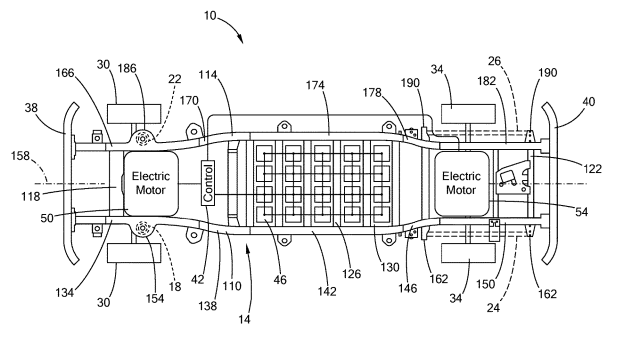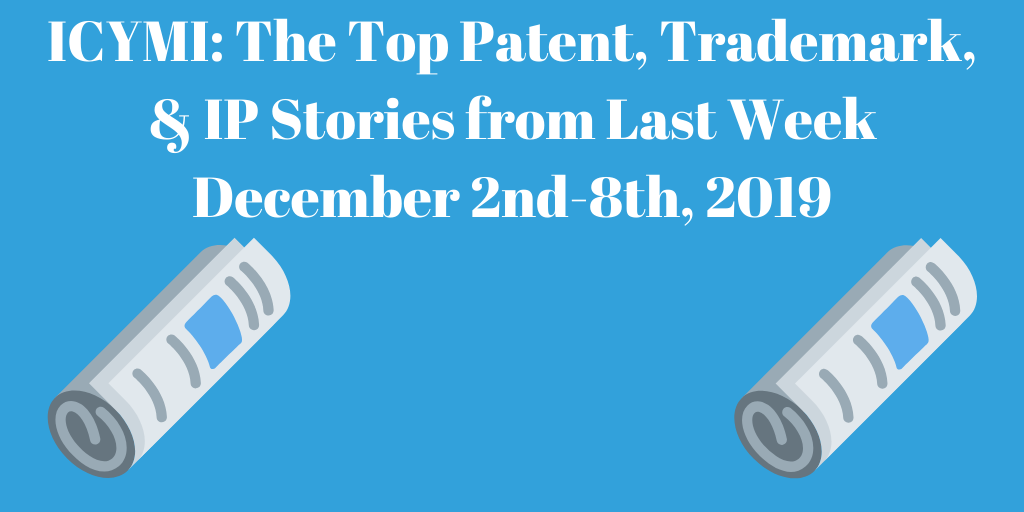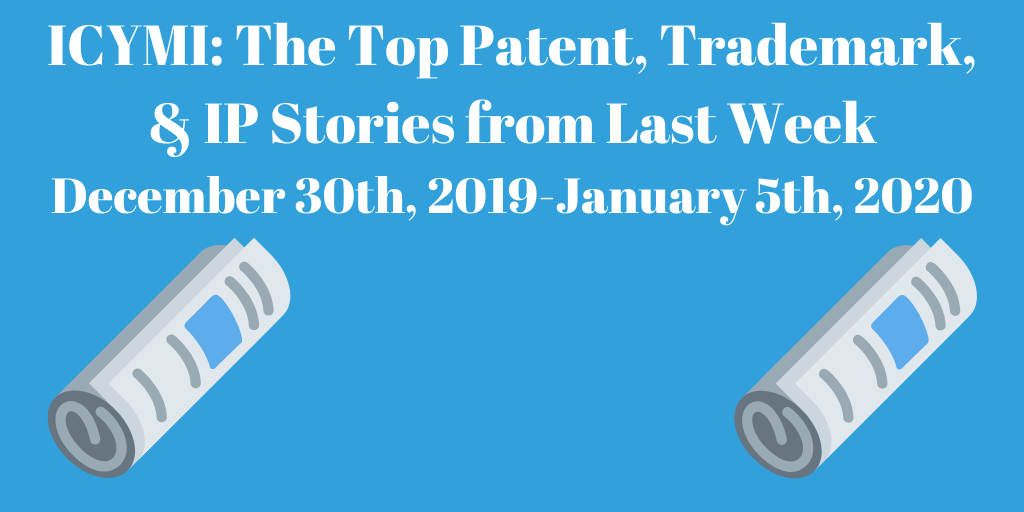Top Patent, Trademark, and IP Stories from Last Week (12/2-12/8/19)
Every week, we will be highlighting the top patent, copyright, trademark, intellectual property, etc. stories of the previous week in our “In Case You Missed It” segment. The list itself is in no particular order and includes a wide range of stories from the patent world that are informative, noteworthy, or just plain bizarre. The stories included encompass everything from Supreme Court cases to insights into growing industries. Please feel free to comment your thoughts on the stories or share an important one we missed!
“Should You Be Allowed to Copyright a Law? We’re Going to Find Out”
Last week, the Supreme Court heard arguments for Georgia v. Public.Resource.Org. The question at the center of the case is whether the government edicts doctrine extends to works, such as annotations, that “lack the ‘force of law” but “which a court deems ‘sufficiently law-like’ to implicate ‘policy interests.” If such annotations are included in the government edicts doctrine, then they would be uncopyrightable just as judicial decisions and legislative enactments are not copyrightable.
In this case, the State of Georgia is arguing that Public.Resource.Org (PRO), a nonprofit organization dedicated to making government documents publicly available, illegally uploaded and distributed copies of “Official Code of Georgia Annotated (OCGA).” The OCGA is a 54-volume collection of Georgia’s statutes with annotations and guidance from the Georgia Code Commission as well as the Georgia Attorney General’s opinions, summaries, and more. The state has a contract with LexisNexis to sell the collection for $412. The state argues the annotations do not have the “force of law” and thus should be exempt from the government edicts doctrine and copyrightable. Public.Resource.Org argues the annotations, given their creation and backing by the state, are public domain.
During arguments on December 2nd, Justice Gorsuch asked the State of Georgia representative why the Court would allow “the official law to be hidden behind a paywall?” given the state legislature has given its “official approval” to the annotations. In response, the representative argued the annotations are “not the law, so the law is not behind a paywall.” When pressed whether annotations are cited by legislature and state courts, the representative argued they are more of “research references or finding aids.”
A previous U.S. Court of Appeals decision went in Public.Resource.Org’s favor ruling that the OCGA annotations are “attributable to the constructive authorship of the People” and thus “intrinsically public domain material. They “[belong] to the People, and, as such, must be free for publication by all,” the court ruled. To read more about this story, click here (via Gizmodo, December 4th, 2019).
“New Bill Would Empower U.S. Customs to Enforce Design Patents at U.S. Border to Combat Imported Counterfeit Goods”
A new bill introduced to the Senate last week aims at granting U.S. Customs and Border Protection agents the authority to seize imported counterfeit goods that infringe on design patents. Under current laws, CBP agents are able to seize goods that infringe on copyrights and trademarks recorded with the agency. However, CBP agents are unable to seize goods that infringe on patents, specifically design patents. This bill would enable CBP agents to close a loophole whereby counterfeit goods that do not feature an infringing mark (intentionally hidden or removed in most cases) are able to bypass agents. Both The Intellectual Property Owners Association and American Intellectual Property Law Association have shown support for the bill as well as Nike and 3M.
Following the introduction of his bill, Sen. Thom Tillis stated that “the inflow of counterfeit goods into the United States is an issue that affects American consumers and businesses alike and results in the American economy losing billions of dollars every year.” He went on to say that the bill will help “stem the flow of counterfeit goods and protect American interests.”
According to a 2017 study cited by the bill’s authors, the economic value of counterfeit goods is expected to rise to $1.9-2.8 trillion in 2022, up from $0.9-1.3 trillion in 2013. In the “U.S. Joint Strategic Plan on Intellectual Property Enforcement” report released a few years back, the government outlined a plan for combating counterfeit goods and IP theft. The report also highlighted the economic consequences of counterfeiting as well as the public safety risks such goods pose to the American public. This is especially true for health and beauty products as well as auto parts. To read more about this story, click here (via IPWatchdog, December 6th, 2019).
“Electric Ford F-150 Patent Reveals Tesla-Fighting Tech”
As the electric pickup truck race heats up, the automakers (mainly Tesla, Ford, and Rivian) have all been revealing possible features for their trucks in recent patents. For example, a new patent from Ford dubbed “Body-on-frame electric vehicle with battery pack integral to frame” outlines a body-on-frame construction whereby the battery pack is housed in a plate welded to both the left and right frame rails. Cross-members in the plate define compartments for the individual power storage units (batteries) which are coupled together to form the battery pack.

Ford claims that with the addition of cross members and strength of the plate, frame rail walls can be thinner than on traditional body-on-frame vehicles thus “reducing weight and cost of the frame.”Additionally the strength of the integrated battery frame means less pathways for “noise, vibration and harshness (NVH)” compared to other electrical vehicle frames. To read more about this story, click here (via CarBuzz, December 7th, 2019).
“We Committed Copyright Infringement and Want to Be Sued by Disney”
In recent years, artists and content creators who post their content online, especially Twitter, have seen a rise in theft of their content. Tweets that go viral featuring a funny meme, drawing, or even the tweet text itself have ended up on shirts on user-submitted apparel sites not authorized by the authors. For years there has been speculation in the artist community of bots sifting through twitter to steal content and immediately put on t-shirts.
That is when Twitter user @Hannahdouken decided it was time to test that theory. She posted an image with “This site sells STOLEN Artwork, do NOT buy from them!” hand-drawn with the tweet caption “hey can y’all do me a favor and quote tweet/reply to this with something along the lines of ‘I want this on a shirt’, thank you.” Followers obliged, retweeting the tweet and commenting how badly they wanted it on a t-shirt. A day later, the image appeared on shirts across numerous apparel sites.
Other twitter users one-upped @Hannahdouken’s example and posted their own drawings featuring notoriously protected characters such as Mickey Mouse, Mario, and Pikachu to bait bots. One Twitter user @Nirbion posted a crude drawing of Mickey Mouse alongside the words “This is NOT a parody! We committed copyright infringement and want to be sued by Disney. We pay ALL court and tribunal fees” and The Walt Disney Company logo. The bots took the bait again and the image also appeared on apparel sites across the web. They were quickly taken down once news of the stunt spread but it was still an informative glimpse into how widespread online content theft is. To read more about this story, click here (via Fortune, December 6th, 2019).




